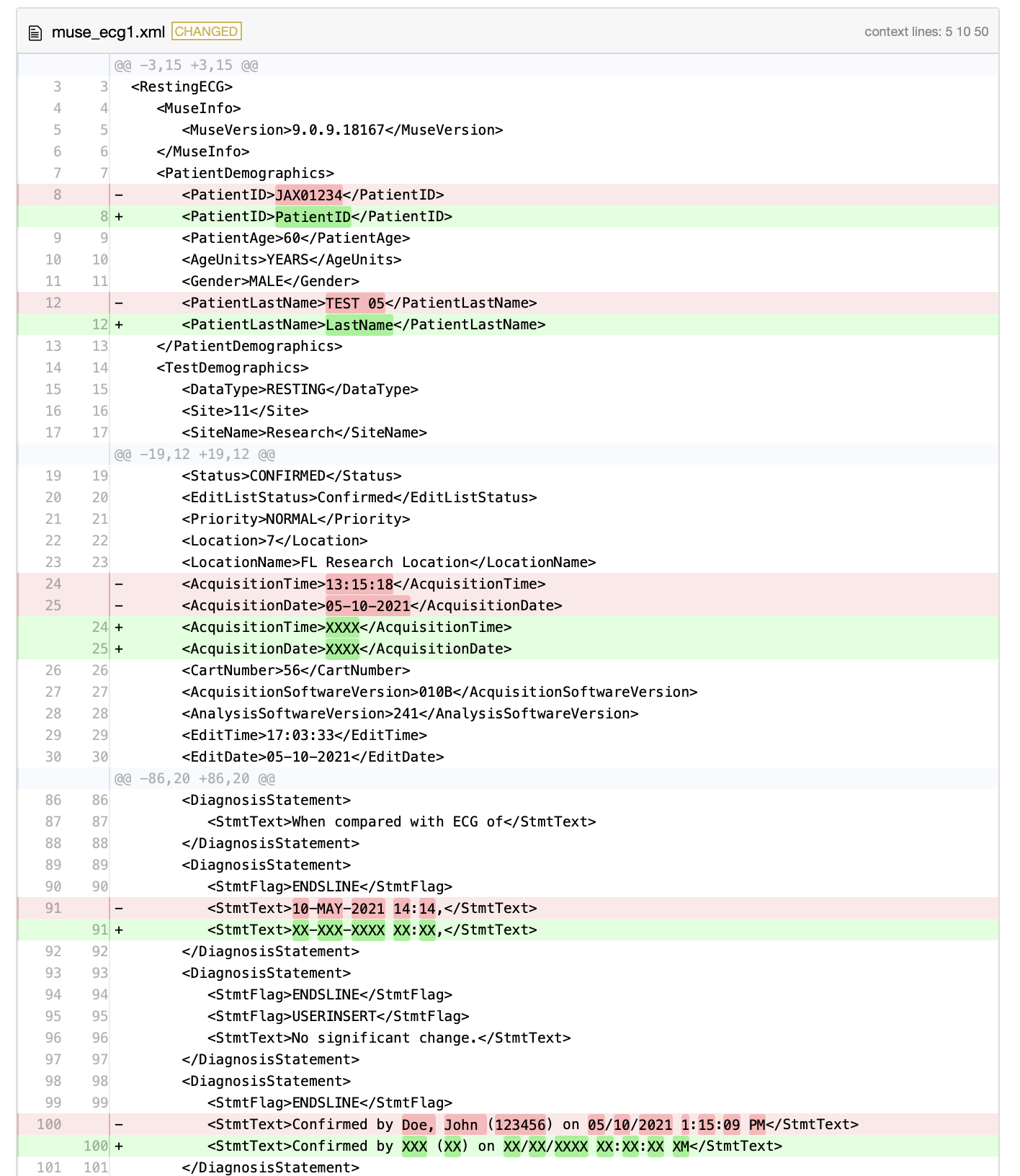musePHI is a package designed to assist in the de-identification of
MUSE ECG XML files. It enables users to replace sensitive patient
information within XML files with placeholders, maintaining the overall
structure of the files. This approach helps in ensuring patient privacy
while allowing the data to be used for research or analysis purposes.
It is the responsibility of the user to accurately identify and replace
values that need to be de-identified from the XML file. Furthermore,
users must validate the results to ensure no personal health information
(PHI) is inadvertently disclosed. The developers of musePHI assume no
liability for the misuse of this software or the inadvertent sharing of
PHI.
You can install the development version of musePHI from GitHub with:
# install.packages("devtools")
devtools::install_github("overdodactyl/musePHI")library(musePHI)The function takes an input XML file, an output file path, and a list of replacement patterns. Each replacement pattern is applied to the text content of specified XML nodes.
The example below shows how regular expressions can be used to replace entire nodes are patterns within nodes.
In order to capture dates and date times within the diagnoses sections, we will construct some regular expressions:
# Create a string of valid month abbreviations
months <- paste(toupper(month.abb), collapse = "|")
# Define regex replacements with specific month abbreviations
dx_replace <- setNames(
list(
# Replacement for date-time format
"XX-XXX-XXXX XX:XX",
# Replacement for date format
"XX-XXX-XXXX",
# Replacement for confirmation format
"Confirmed by XXX (XX) on XX/XX/XXXX XX:XX:XX XM"
),
c(
paste0("\\d{2}-(", months, ")-\\d{4} \\d{2}:\\d{2}"),
paste0("\\d{2}-(", months, ")-\\d{4}"),
"Confirmed by [A-Za-z]+, [A-Za-z]+ \\(\\d+\\) on \\d{1,2}/\\d{1,2}/\\d{4} \\d{1,2}:\\d{2}:\\d{2} [APM]+"
)
)Below, we construct a full list of replacements. ".*" is used to
replace an entire node.
replace <- list(
"/RestingECG/PatientDemographics/PatientLastName" = list(".*" = "LastName"),
"/RestingECG/PatientDemographics/PatientFirstName" = list(".*" = "FirstName"),
"/RestingECG/PatientDemographics/PatientID" = list(".*" = "PatientID"),
"/RestingECG/PatientDemographics/DateofBirth" = list(".*" = "XXXX"),
"/RestingECG/TestDemographics/AcquisitionTime" = list(".*" = "XXXX"),
"/RestingECG/TestDemographics/AcquisitionDate" = list(".*" = "XXXX"),
"/RestingECG/Diagnosis/DiagnosisStatement/StmtText" = dx_replace,
"/RestingECG/OriginalDiagnosis/DiagnosisStatement/StmtText" = dx_replace
)Specify the path to your existing XML file and the path for the new
de-identified XML file. Then, call muse_deidentify:
file <- muse_example("muse/muse_ecg1.xml")
output_file <- tempfile(fileext = ".xml")
muse_deidentify(file, output_file, replace)We recommend use a file diff viewer to visually inspect some replacements to make sure only the intended changes are being made.
This could be done with the diffviewer R package:
diffviewer::visual_diff(file, output_file)It could also be done via the diff linux tool:
cmd <- paste("diff -u", file, output_file)
res <- system(cmd, intern = TRUE)
#> Warning in system(cmd, intern = TRUE): running command 'diff -u
#> /apps/scratch/RtmpPXPjzJ/temp_libpath2a85bc5f742b1d/musePHI/extdata/muse/muse_ecg1.xml
#> /apps/scratch/RtmpkNrgdZ/file2afdec794abf0e.xml' had status 1
cat(res, sep = "\n")
#> --- /apps/scratch/RtmpPXPjzJ/temp_libpath2a85bc5f742b1d/musePHI/extdata/muse/muse_ecg1.xml 2024-06-23 17:50:06.707066572 -0500
#> +++ /apps/scratch/RtmpkNrgdZ/file2afdec794abf0e.xml 2024-06-23 17:50:13.996066024 -0500
#> @@ -5,11 +5,11 @@
#> <MuseVersion>9.0.9.18167</MuseVersion>
#> </MuseInfo>
#> <PatientDemographics>
#> - <PatientID>JAX01234</PatientID>
#> + <PatientID>PatientID</PatientID>
#> <PatientAge>60</PatientAge>
#> <AgeUnits>YEARS</AgeUnits>
#> <Gender>MALE</Gender>
#> - <PatientLastName>TEST 05</PatientLastName>
#> + <PatientLastName>LastName</PatientLastName>
#> </PatientDemographics>
#> <TestDemographics>
#> <DataType>RESTING</DataType>
#> @@ -21,8 +21,8 @@
#> <Priority>NORMAL</Priority>
#> <Location>7</Location>
#> <LocationName>FL Research Location</LocationName>
#> - <AcquisitionTime>13:15:18</AcquisitionTime>
#> - <AcquisitionDate>05-10-2021</AcquisitionDate>
#> + <AcquisitionTime>XXXX</AcquisitionTime>
#> + <AcquisitionDate>XXXX</AcquisitionDate>
#> <CartNumber>56</CartNumber>
#> <AcquisitionSoftwareVersion>010B</AcquisitionSoftwareVersion>
#> <AnalysisSoftwareVersion>241</AnalysisSoftwareVersion>
#> @@ -88,7 +88,7 @@
#> </DiagnosisStatement>
#> <DiagnosisStatement>
#> <StmtFlag>ENDSLINE</StmtFlag>
#> - <StmtText>10-MAY-2021 14:14,</StmtText>
#> + <StmtText>XX-XXX-XXXX XX:XX,</StmtText>
#> </DiagnosisStatement>
#> <DiagnosisStatement>
#> <StmtFlag>ENDSLINE</StmtFlag>
#> @@ -97,7 +97,7 @@
#> </DiagnosisStatement>
#> <DiagnosisStatement>
#> <StmtFlag>ENDSLINE</StmtFlag>
#> - <StmtText>Confirmed by Doe, John (123456) on 05/10/2021 1:15:09 PM</StmtText>
#> + <StmtText>Confirmed by XXX (XX) on XX/XX/XXXX XX:XX:XX XM</StmtText>
#> </DiagnosisStatement>
#> </Diagnosis>
#> <OriginalDiagnosis>
#> @@ -130,7 +130,7 @@
#> </DiagnosisStatement>
#> <DiagnosisStatement>
#> <StmtFlag>ENDSLINE</StmtFlag>
#> - <StmtText>10-MAY-2021 18:34,</StmtText>
#> + <StmtText>XX-XXX-XXXX XX:XX,</StmtText>
#> </DiagnosisStatement>
#> <DiagnosisStatement>
#> <StmtFlag>ENDSLINE</StmtFlag>NOTE: It is recommended to save the de-identified ECG data to a new file to preserve the original data.
For users working with a large number of XML files, parallelization can significantly speed up the de-identification process. We recommend using the furrr package to efficiently parallelize your workload.
To demonstrate this, we will process 10000 XML files sequentially and in parallel using 10 CPUs.
First, create 10000 XML files in a temporary directory:
dir <- fs::path_temp("xmls")
fs::dir_create(dir)
for (i in 1:10000) {
fs::file_copy(
"inst/extdata/muse/muse_ecg1.xml",
fs::file_temp(tmp_dir = dir, ext = ".xml")
)
}Next, create a list of XML files and create their new file paths:
xml_files <- fs::dir_ls(dir)
deidentified_dir <- fs::path_temp("deidentified_xmls")
fs::dir_create(deidentified_dir)
deidentified_xmls <- fs::path(deidentified_dir, fs::path_file(xml_files))library(tictoc)Run muse_deidentify sequentially:
tic()
for (i in seq_along(xml_files)) {
muse_deidentify(xml_files[i], deidentified_xmls[i], replace)
}
toc()
#> 44.404 sec elapsedRun in parallel:
library(furrr)
#> Loading required package: future
plan(multisession, workers = 10)tic()
future_walk2(xml_files, deidentified_xmls, muse_deidentify, replace = replace)
toc()
#> 9.559 sec elapseddiagnoses <- future_map_dfr(deidentified_xmls, muse_diagnoses)
diagnoses |>
dplyr::count(value, sort = TRUE)
#> # A tibble: 14 × 2
#> value n
#> <chr> <int>
#> 1 ENDSLINE 110000
#> 2 USERINSERT 20000
#> 3 When compared with ECG of 20000
#> 4 XX-XXX-XXXX XX:XX, 20000
#> 5 , age undetermined 10000
#> 6 Abnormal ECG 10000
#> 7 Confirmed by XXX (XX) on XX/XX/XXXX XX:XX:XX XM 10000
#> 8 Lateral infarct 10000
#> 9 Left axis deviation 10000
#> 10 No significant change. 10000
#> 11 Non-specific intra-ventricular conduction block 10000
#> 12 Previous ECG has undetermined rhythm, needs review 10000
#> 13 Ventricular-paced rhythm 10000
#> 14 Wide QRS rhythm 10000